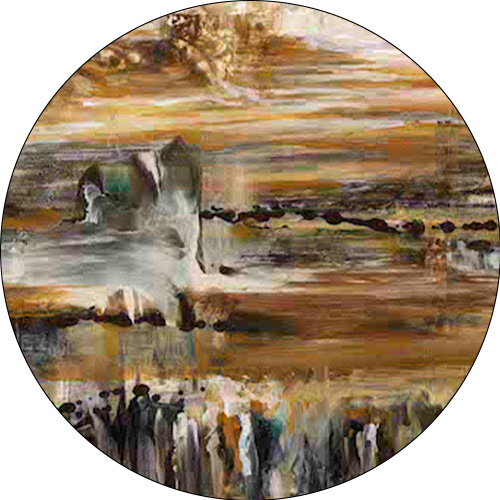Rebuilding the Walls

The Three Weeks is a time to strive to bring back the focus, the love, the desire for connection with Hashem

R
ambam teaches us that a fast day is a day of introspection and teshuvah. Understanding the reason behind the fast lends meaning to the day and guides us toward proactive steps we can take to bring redemption. Chazal teach us that five calamities happened on Shivah Asar B’Tammuz.
- When Moshe Rabbeinu descended from Har Sinai and saw the people worshipping the Golden Calf, he broke the Luchos.
- Toward the end of the Second Beis Hamikdash era, Apostomus, a Greek general, publicly burned a sefer Torah. (Some explain that this was a special Torah written by Ezra Hasofer.)
- The enemies prevented the Jews from offering the daily sacrifice.
- An idol was erected in the Beis Hamikdash.
- The walls of Yerushalayim were breached, which led to the destruction of the Second Beis Hamikdash.
What’s the connection between these seemingly disparate events, and what message can we take from them?
Monumental Loss
The sin with the Golden Calf wasn’t just a localized event; rather it changed the entire course of history. Hashem intended that the Revelation at Har Sinai would climax with the Jews receiving the Luchos. There would have been a complete fusion between the Jews and the Torah, and they would have been fundamentally free from sin.
Likewise, notes the Seforno, before the sin with the Golden Calf, there was no necessity for a Mishkan, nor for any specific place for Hashem to reside in. Hashem could be found within everyone; each person was a repository for the Shechinah. When the Jews sinned with the Golden Calf, they lost the chance for that deeper, higher level of connection.
Shivah Asar B’Tammuz is a time to reflect on the enormity of this loss and its effect on us until today. When we struggle with our davening, learning, chesed, and observance of mitzvos, it’s often because we lack this feeling of spiritual closeness. Rav Wolbe notes that a person can daven an entire tefillah and not once think about Hashem! One appropriate aspect of the teshuvah we can do on this day is to work on intensifying our relationship with Hashem.
The period of the Three Weeks is a time to strive to bring back the focus, the love, the desire for connection with Hashem, in the revealed way that was lost with the breaking of the Luchos. Rav Wolbe suggests we spend a bit more time focusing on the brachos in Shemoneh Esreh and Bircas Hamazon that are connected with Yerushalayim, and allow ourselves to yearn for its rebuilding, which will enable us to once again reconnect with HaKadosh Baruch Hu in a real, meaningful manner.
Ripple Effect
In Darash Dovid, Rabbi Dovid Hofstedter explains that all the other misfortunes that occurred on this day are a direct result of the sin of the Golden Calf. As a result of the sin, Hashem’s Presence was limited to one locale, giving the nations the ability to prevent us from bringing the daily sacrifice. In the pre-Golden Calf era, we would have been able to offer sacrifices wherever we were.
Another major setback from this sin was that the Jews were no longer impervious to the forces of evil or the dominion of foreign nations. Our enemies’ success in breaking down the walls of Yerushalayim, beginning its destruction, is also rooted in the moment Moshe Rabbeinu broke the Luchos.
The original Luchos are described as charus, “engraved,” which Chazal understand with different vocalization as cheirus, “freedom.” Had we received the first set of Luchos, we would have been free from all forces of evil, including the Angel of Death. Further, our learning Torah would have been easier, and we would not be subject to forgetfulness. The burning of the Torah is a reminder of the struggles we face in learning since the breaking of the Luchos. Finally, the idol in the Beis Hamikdash is a mirror of the Jews who built the Golden Calf in the holiness of Hashem’s encampment.
Darash Dovid learns an important lesson from the thread running through all of these events. At times, a person may sin and minimize its gravity. But as we clearly see, this one sin of the Golden Calf had ripple effects for generations to come. None of us know the power of one mitzvah or one aveirah that we do, and how it can bring many things in its wake.
In Ohr Yechezkel, Rav Yechezkel Levenstein, explains that in the future we will have to give a din v’cheshbon. The din, judgment, will be on the actions that we did, and the cheshbon, accounting, will be on why we didn’t properly consider the long-term effects of each thing we said or did.
Fortifying the Fences
A third appropriate area of introspection during this period is examining the security of the “walls” that protect the purity of our homes. Yeshayahu Hanavi (62:6) describes the walls around Yerushalayim: “Al chomosayich, Yerushalayim, hifkadti shomrim kol hayom v’chol halailah.” The guard corps surrounding the city was a reflection of Yerushalayim’s honor and kedushah. Once the walls were breached, the Beis Hamikdash’s kedushah was imperiled.
In Sichos Mussar, Rav Chaim Shmuelevitz offers a profound insight on the importance of creating fences. Imagine, he says, building a fence around a field, but leaving a small hole, big enough for a rabbit to squeeze through. Obviously, the field is no longer protected. Similarly, he explains, the fences we create for ourselves to protect us from negative influences need fortifying, because even a small breach can let so much impurity in.
Connection and Protection
This year, Shivah Asar B’Tammuz falls out on Shabbos Kodesh. Another aspect of teshuvah could involve strengthening our Shabbos observance and proactively using the day to foster greater connection with Hashem. “V’shamru Bnei Yisrael es haShabbos.” Shabbos also needs fences in place to keep us from frittering away the day.
There’s another fascinating connection between Shivah Asar B’Tammuz and Shabbos. In Halekach Vehalebuv on Tammuz and Av, Rav Schorr notes that the underlying cause of the Sin of the Golden Calf was the fact that the Jews did not keep their first Shabbos, when they went to collect the mahn. Chazal note that had we kept this Shabbos, we would have been protected from all enemies. Instead, parshas Beshalach ends with the war against Amalek, who infected the Jews with the spiritual impurity that ultimately led to the Sin of the Golden Calf.
Rav Tzaddok HaKohein explains that Erev Shabbos is the key to a successful Shabbos. Tammuz stands for “tam vav zayin, the completion of the sixth and seventh.” We need to use both Erev Shabbos and Shabbos correctly to access the spiritual benefits that are inherent within them.
While the Three Weeks are a period of mourning, and there are several restrictions to reflect that, we can’t get stuck there. With the beginning of this period on Shivah Asar B’Tammuz, we need to utilize the energy of this time to work on rebuilding. We need to strengthen our personal relationships with Hashem, yearn for His closeness, and protect ourselves from those things that distance us from Him.
In the merit of all of our endeavors, may we individually and collectively merit to see redemption.
(Originally featured in Family First, Issue 801)
Oops! We could not locate your form.






